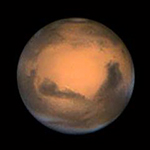|

Jupiter
pictured through a T.16"
by
D.Parker, ALPO

Mars
at perihelic opposition
pictured
by John
Earl in 2016

Neptune
and Triton pictured in 2015
by Damian Peach with a C14
|
PLANETARY
ACTIVITY
From Venus to
Saturn there are lots of monitoring activities accessible to amateurs
using medium scopes. A typical planetary scope should have a long focal
to get a power great enough to see features in the atmospheres and an aperture over
4" to say that we see something else than a colored ball suspended in the sky.
The major
activities are :
-
Monitoring the constantly changing in the atmospheric conditions on
Jupiter including the red spot appearance along the years
-
Looking for occasional white spots on Saturn and disturbances in its
rings system
-
Monitoring climate changes on Mars during oppositions (mainly in the
northern cap)
-
Survey the atmosphere of Venus in quest of unusal spots
The
Association of Lunar and Planetary Observers, ALPO, in collaboration
with universities and international institutions organizes for decades
such programs and much more. They can provide you documentation, models
and a survey program that fit to your specifications and interests.
Planets
like Mercury, Neptune and Pluto are more
bright "stars" than subjects of monitoring. Their disk is so
small that using a 20-30 cm (8-12") telescope you cannot see more
than a small pinpoint. No details, no spot, thus without great interest
other than the satisfaction to have seen the outer members of the solar
system. You need a scope from 14" with colored (contrast) filters
to start seeing some surface details, mainly by photography after
stacking numerous individual frames.
|
Planet
|
Apparent
size
|
Magnitude
|
|
Mercury
|
4.5"-13"
|
-2.1/+5.8
|
|
Venus
|
66"-9.7"
|
-4.6/-3.7
|
|
Mars
|
25.1"-3.5"
|
-2.9/+1.8
|
|
Jupiter
|
29.8"-50.1"
|
-2.8/-1.6
|
|
Saturn
|
14.5"-20.1"
with rings
|
-0.24/+1.2
|
|
Uranus
|
3.3"-4.1"
|
5.3/6.0
|
|
Neptune
|
2.2"-2.4"
|
7.8/8.0
|
|
Pluto
|
0.06" 0.11"
|
13.6/15.1
|
|
During
its oppositions Mercury yield a large disk 13" wide, almost half the one
of the Moon but without visual details. It is only at high magnifications
and stacking several frames that surface details can appear.
After
Jupiter, it is Mars and specially during perihelion oppositions that shows
the most surface details when its diameter is ranging between 18-25".
But
this is not a reason to not regularly look at the other planets to see an occasional
bright or dark spot. What happended on Jupiter when comet SL9 collided with
hit in 1994 may occur tomorrow on any other planet.
|